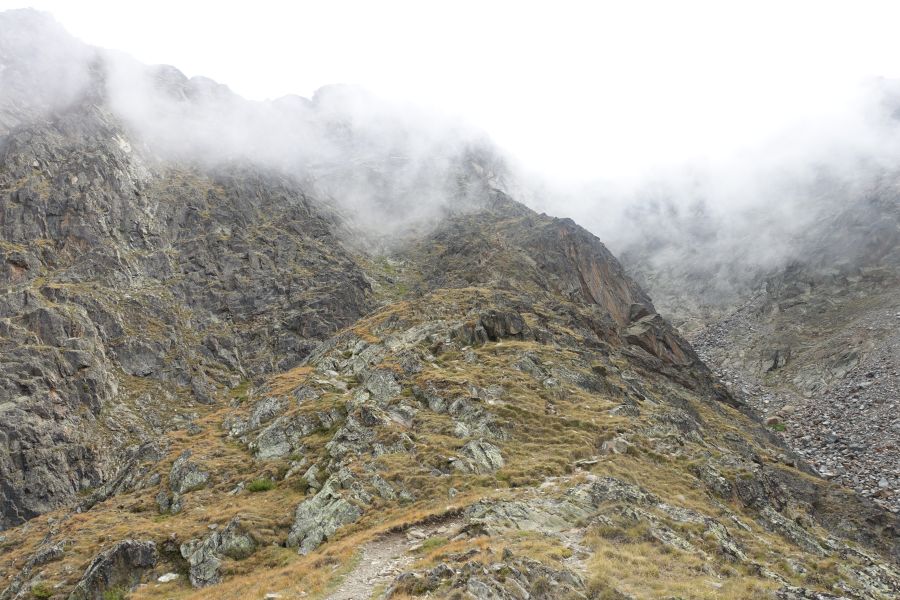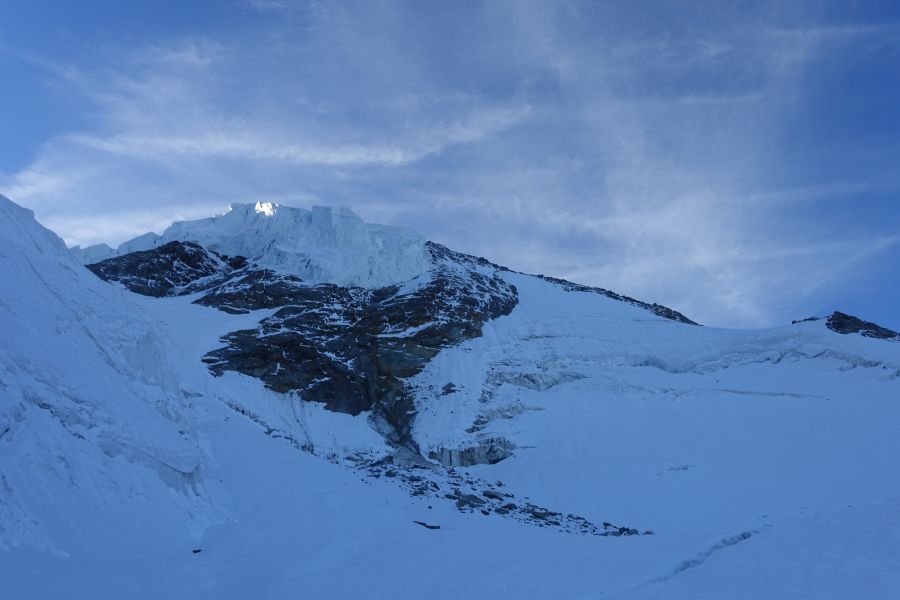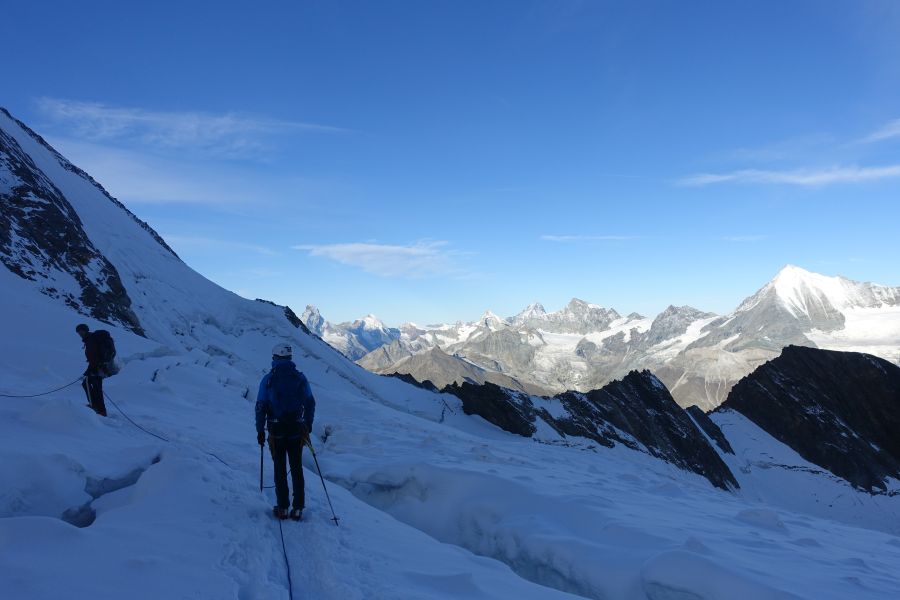One of the highest peaks in the alps, with a moderate difficulty, is the Dom. Located in the Mattertal, 33 of the 82 4000er lie there, including Matterhorn and Dufourspitze, it is the highest Swiss mountain with its base all the way in Switzerland. We were a bit undecided during a Switzerland holidays, how to make the best use of a short weather window, several options looked into and dropped again and somehow Dom came up, and it was perfect. For me, it was the first 4000er, the rest said it was one of the nicest (also due to perfect weather), which they did so far, no cable cars around, best views and a proper deserved summit. Our tip was mid-August 2022, on the first day just the arrival at the hut, second day peak and back to the hut, theoretically you can also go all the way down immediately. We spent another night to have it more relaxed and as the following day just the return trip was on our plan.
 Source: mapy.cz. Starting point is the village of Randa, via point 2 you reach the suspension bridge, Domhütte (4) and summit (6).
Source: mapy.cz. Starting point is the village of Randa, via point 2 you reach the suspension bridge, Domhütte (4) and summit (6).
Transportation
From Zurich there is a train connection in 2:50h with one time changing to Randa, just next door lies Zermatt at the end of the village.
We arrived by car. Parking lots were just around the train station, signs for others as well, but all (private) ones are for the same price. Therefore, you can avoid driving around through narrow streets and can just take something around the train station. It should have been 5 CHF per day.
Hike
Day 1- Reaching Domhütte, 4 h, 1500m uphill
Just to the Domhütte it is already around 4h and 1500 m uphill, if you are not a way-beyond-average fit mountaineer, the Dom takes 2-3 days. We arrived around lunchtime and then just started the bit longer path to the Domhütte via the suspension bridge. At the time of construction, it was the longest bridge of this kind worldwide. The detour is only around half an hour.

After passing the bridge, there is the option to continue to the Europahütte, around 15 min, for possible lunch break or just sleeping over and skipping the rest of the tour. Till here it is all normal easy paths, the higher it gets, the more alpine (surprise!). Some parts are rope-secured, sometimes the hands are needed, but nothing dramatic. Several other people also just went to the Domhütte without the aim to reach the summit. As soon as the clouds cleared up a bit and freed the view to Weißhorn, I completely got it, that it is also worth it.



For me, not known from Austria, were the glaciers hanging all the way down the faces and being visible also from the streets. Will not take too long anymore and due to the glacier melt they will disappear further, but till now at least smaller parts are still hanging all the way into the faces. The path was always easy to find, well-marked, and soon we reached the Domhütte. It took around 3,5 h with a decent speed, but heavy, heavy luggage. Each brought 5 l of water as we wanted to avoid to pay 12 CHF/€ for a bottle of water in the hut, I had my glacier shoes in addition on the backpack to let my blister-suffering heels recover a day longer.


After a short break, I continued a bit to check the path for the next day. Breakfast was to choose from either 2:30 or 7:30, the biggest fun to start when it is dark and cold. We wanted to be sure about the path and that it is possible to find when dark. It proved to be easy, cairns every few metres and a logical path between the glacier and the rock face to the left. When the hut is booked out, it seems that people also bivouak around the hut, one decent spot was around 250 m higher than the hut, where someone prepared a nice shelter for a probably short and cold night.

When the clouds cleared up, the summit got also visible. The ridge to the left from the summit is the Festigrat, a difficulty II-III climb to the top, the normal/easier path reaches the Dom from the back. During dinner, finally the clouds around Matterhorn disappeared as well and we got a stunning view to the probably most famous mountain of the alps. 
Day 2- summit and back to hut: around 11h
Alarm rang around 2:30, breakfast started at the same time. The day before, it was still snowing, no one reached the summit, there were only 2 groups on the mountain: four German guys and a mountain guide with his client, all needed to turn around. The snow was too much and with the wind and cold it was not possible for them reaching the top. Which means for us that there were no traces so far and no reason to stress in the morning to leave first (and before the guides, who would pass us anyways soon). An hour later, at 3:30, we left the hut and followed a long crowd up, around 25 people in front of us and 15 Italians behind. The start is relaxed, just following the cairns and approaching the glacier. There we put on our crampons, harness and all other equipment we already got in the hut. The less you need to wait and get stuff ready on a glacier in the dark, the more relaxed it is. On the glacier, we just followed the steps of the others till the start of the climb to Festijoch. There a long queue was already waiting. Climbing was up to III, mainly easier, with crampons and not too many fixing options still a challenge. In the cold, with the dawn only breaking, we froze a bit. I was more than happy with every layer of clothes I had, two layers merino, one softshell, one thin dawn jacket and on top a hardshell rain jacket. In addition, thin leather gloves, plus thin waterproof overmitts, made it bearable. In the end we waited around 1 h till it was our turn to start, at least the views were great: in the valley still clouds and on the other side the first headlamps got also visible of the people ascending Weißhorn.

Top: the Italian group also preparing for the short climb, behind the impressive Weißhorn.
Bottom: headlamps moving up the face very, very slowly.


Now it was our turn, we should have used the waiting time to prepare ourselves, change equipment (for the lead climber to have most) and to talk everything through. After some short delays in the beginning, we got into moving, one person leading on the long rope from anchor to anchor and then securing the other 3, who followed on the short rope between ourselves. Make sure that the first has enough rope to reach the next fixing point. It always just worked out, the Italians were smarter and the lead climber had the spare rope to be able to extend it in case it is needed. Anchors were not too many, sometimes also not sure if it is some in-between-point or already the fixed anchor. The rocks can also be used to sling the rope around and overall it offered very solid holds and just one part in the beginning was slightly more tricky. These parts are also the most difficult on the whole climb and give the difficulty PD- on the French scale.
After reaching the Festijoch (3720 m) it is a short part down, till a newly installed ladder. The crevasse for reaching the Hohberg glacier got too big, but with the new wooden ladder it was possible again to cross. Now the kind of endless walk through the glacier starts, the entire North-West side of the Dom is covered from the Hohberg glacier, impressive on pictures but a long (though rather easy) walk. Around 4000 m I felt the air getting thinner and thinner, we were pretty good acclimatized, several days around 3000 m, highest point 3800, sleeping just below 3000. Nonetheless, the pace is getting more slowly, we tried to avoid having many breaks, but just walking a constant speed seemed best. In theory a perfect plan, in practice one guy lost his crampons the whole time and needed to adjust them again and again and again. Afterwards he was pissed, started with a high pace and the rest was breathing hard on the rope to keep up to it. The seracs hanging high above us also gave proof why it is important to start early on hot days, so far I have not read any accidents of them falling down, better being safe than sorry. Most accidents I read from Dom were single climbers, who fell on the climb to Festijoch.



The long, but incredibly beautiful walk to the summit, towards the sun.
Around 9:30, we reached the summit, 6 h after leaving the hut, so just as estimated despite the long waiting time. From Dom nearly everything known from the alps is visible, Mont Blanc, Matterhorn,... Difficult to get any better view, I think. The way down follows the same path, the most time-consuming part was the abseiling from Festijoch. Theoretically, you can also down climb unsecured, but it seemed wiser and safer to be on the rope and just go down like that. If you abseil there the first time in your life, it is maybe not the most perfect place to learn, and it leads to queues. With a blue sky all relaxed, but I can imagine that it is more annoying with windy, cold weather.

The end of the abseil part, the snow bridge towards the face, already got very narrow in mid-August. It seems, that it stayed there till the end of the season. If it gets warmer in the upcoming years with less snow, there might be the need for a ladder as well to cross from the glacier to the rocks. After leaving the glacier we split up and all returned individually to the hut, I took pictures of animals, the others were aiming for an earlier beer. The hut was just great, newly renovated with cosy rooms, very good dinner, both meat and vegetarian options tasted super, and it was possible to get refills. A young and motivated team made our two nights there very enjoyable and highest recommendations also to go there even if you do not want to go to the Dom. Surprising to us the beer on Swiss huts was not that expensive, 6 € is not that much more than in Austria and better investment than 12 € for 1,5l of water.

Day 3- descent: 2-3 h, 1500m down
Hardly any water left, several kilograms lighter than two days before, we left the hut after breakfast and in just around 2 h we were back down at the car. The suspension bidge we skipped and just went straight for the town, in the beginning last views to Weißhorn and then just back to the car.
